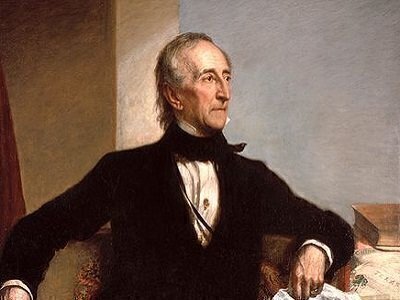On the 227th birthday of John Tyler, Constitution Daily looks back at the legacy of a most unusual President who established the concept of presidential succession and eventually was elected to the Confederate Congress.
 Perhaps Tyler’s greatest contribution to the Constitution and history in general were his actions after the death of newly inaugurated President William Henry Harrison in April 1841. Vice President Tyler quickly settled a debate about who replaced the President in what capacity.
Perhaps Tyler’s greatest contribution to the Constitution and history in general were his actions after the death of newly inaugurated President William Henry Harrison in April 1841. Vice President Tyler quickly settled a debate about who replaced the President in what capacity.
But soon after assuming his role in the White House, Tyler so offended his own party members that he was outcast from the Whig Party while still in office.
In general, historians don’t hold Tyler in high regard as a President. In surveys since World War II, Tyler isn’t ranked as the worst President, but he is always in the bottom 10 of historian’s rankings.
Born on March 29, 1790 in Virginia, Tyler served as a member of the House of Representatives and the Senate, and as Virginia’s governor. He was also a Southern states-rights advocate who became attracted to the Whig Party that opposed Andrew Jackson.
Tyler seemed an afterthought on the 1840 Whig ticket that featured the slogan, “The slogan "Tippecanoe and Tyler Too."
But on April 4, 1841, President Harrison died just 30 days after taking the office. What happened next was a constitutional crisis that ended with a bold move taken by Tyler.
Tyler didn’t take the oath then as President because no one in Washington knew what to do next. The Constitution was very unclear about the concept of presidential succession- a fact that party leaders like Henry Clay, Daniel Webster and Tyler soon realized.
When Tyler met with Harrison’s cabinet soon after the event, many members called him the “Vice President acting as President.” He was also informed by Webster that the cabinet decided administration issues by a vote, with the President only having one vote in the process
Tyler quickly ended that practice and established the “Tyler Precedent” that made it clear that a Vice President assuming office had the full powers and title of the President.
Tyler’s decision in 1841 to assume the full role of President upon the death of his predecessor was used eight times to assure that the office of President was held legally, until the 25th Amendment made the practice officially part of the Constitution. Tyler’s reluctance to be a caretaker President soon led to criticisms and a new popular nickname, “His Accidency.”
For the rest of his presidency, Tyler battled with the rest of the Whigs (the party that got him elected), was kicked out of the party, and used the veto 10 times.
In 1842, after Tyler vetoed a tariff bill, the first impeachment resolution against a President was introduced in the House, but the resolution failed. Tyler was also the first President to have a veto overridden.
Despite being outcast from the Whigs and the Democrats, Tyler sought re-election in 1844 against overwhelming odds. He pushed for the annexation of Texas to help his chances, but dropped from the campaign after an appeal from Jackson.
Late in his life, Tyler tried to broker a solution to Southern secession, but when that failed, Tyler was named to the Confederate Congress in 1861 as a delegate from Virginia.
Tyler died in 1862 before assuming his seat and he received a state funeral from Confederate president Jefferson Davis. President Abraham Lincoln and the federal government didn’t acknowledge his death.
The Brooklyn (N.Y.) Daily Eagle did report Tyler’s death, noting that Union troops now occupied his former estate and Virginia was ravaged by war. “John Tyler did perhaps as little as any man to prevent these evils,” the newspaper said.






